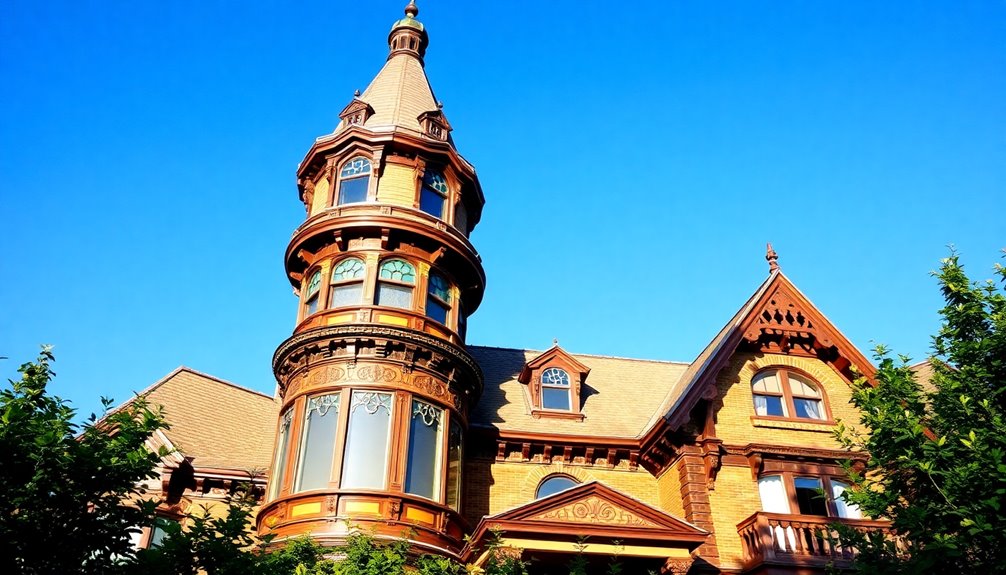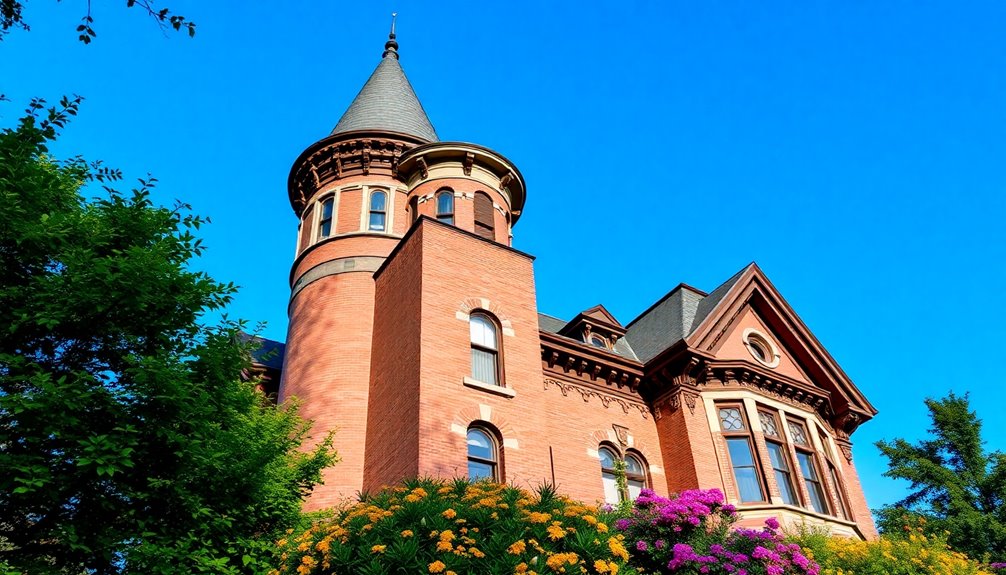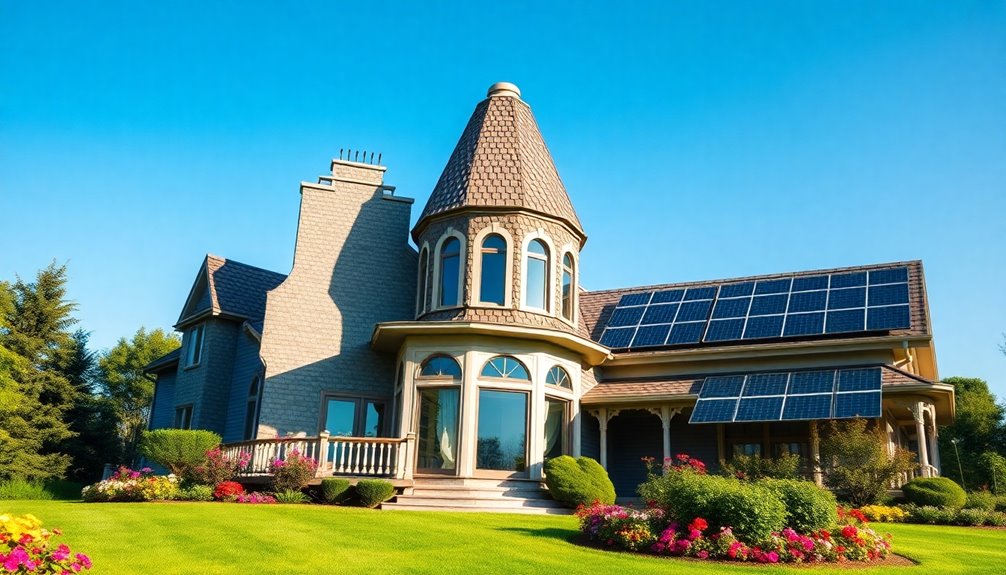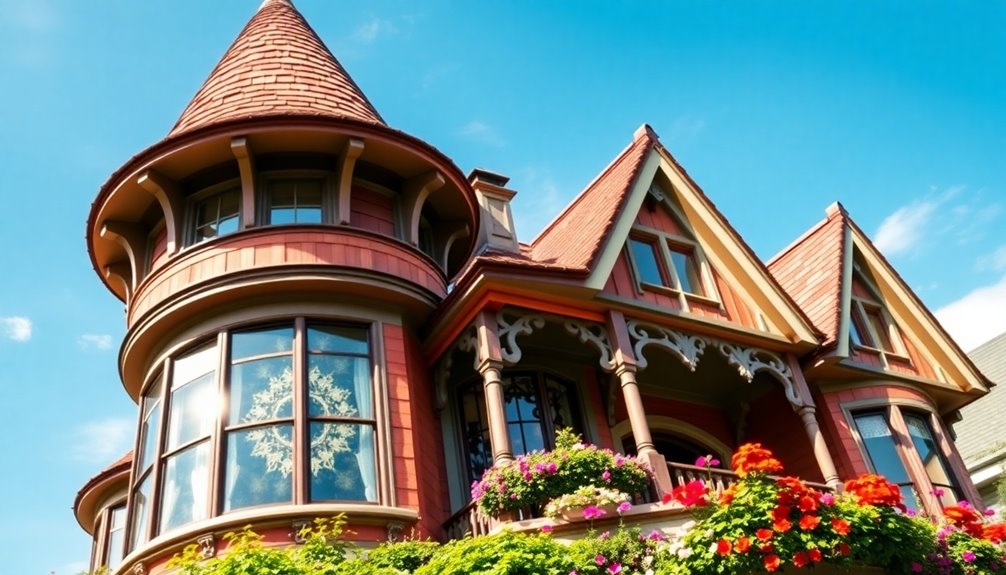If you're wondering what style house has a turret, you'll find them in several architectural styles. The Victorian era is one of the most iconic, featuring ornate details and unique shapes. Gothic Revival homes boast tall, narrow turrets adorned with battlements, while Châteauesque architecture showcases grand, elegant designs. Turrets also appear in Arts and Crafts movement houses, blending rustic charm with simplicity. These structures not only add beauty but also often serve functional purposes. Explore further to discover even more about the fascinating history and variety of turrets in architecture!
Key Takeaways
- Turrets are commonly found in Victorian architecture, particularly in Queen Anne and Gothic Revival styles, showcasing unique shapes and ornate details.
- Gothic Revival houses feature tall, narrow turrets with steep roofs and battlements, emphasizing a medieval aesthetic.
- Châteauesque style homes prominently display grand turrets, inspired by French architectural elegance and opulence.
- Arts and Crafts movement houses often incorporate simpler, rustic turret designs, reflecting a focus on craftsmanship and natural materials.
- Modern residential designs utilize turrets for added interior space and visual interest, blending traditional elements with contemporary features.
Definition and Historical Context

Turrets are fascinating architectural features that combine functionality and aesthetic appeal. A turret is a small tower or projection extending from a building, often serving purposes like defense, observation, or decoration.
Historically, they originated in medieval castles, primarily for defense. As time went on, especially during the Renaissance, turrets transformed into ornamental elements found in palaces and mansions.
By the Victorian era, they became a staple in domestic architecture, particularly in Gothic Revival and Queen Anne styles. These small towers can vary in shape and size, showcasing the diverse architectural styles they've graced, from Gothic to Art Nouveau.
Today, turrets symbolize power and grandeur, enriching the historical and cultural narrative of the buildings they adorn.
Types of Turrets

When exploring the various types of turrets, it becomes clear that these architectural features serve multiple purposes beyond their striking appearance.
Decorative turrets, often adorned with intricate carvings, create focal points and add visual interest, especially in Victorian-era buildings.
Functional turrets, originally designed for defense, feature narrow windows and thick walls, providing observation points in medieval castles.
Residential turrets, with their rounded or pointed tops, can enhance modern homes while offering extra interior space for activities like studying.
Lastly, industrial turrets serve practical purposes, built from robust materials for watchtowers or control rooms.
Each type reflects a unique blend of history and design, showcasing how turrets can adapt to various architectural needs. Moreover, Hyundai tuning techniques can similarly enhance the performance and appeal of vehicles, paralleling the transformative effect turrets have on buildings.
Architectural Styles Featuring Turrets

As you explore the world of architectural styles, you'll find that turrets play a significant role in enhancing the character and charm of various buildings.
The Gothic Revival style features tall, narrow turrets with steeply pitched roofs, often adorned with battlements, reflecting its medieval inspiration.
In Victorian architecture, turrets come in various shapes and are known for their ornate details, adding eclectic charm.
The Châteauesque style showcases grand turrets that evoke a sense of French elegance, while the Arts and Crafts movement emphasizes simplicity with rustic turret designs.
Each style brings its unique flair, making turrets a captivating element that enriches the overall aesthetics of these architectural wonders.
Historical Examples of Turrets

Throughout history, countless architectural marvels have showcased the beauty and functionality of turrets. You can find stunning examples in medieval castles like Windsor Castle and Caernarfon Castle, both featuring impressive turrets that served defensive purposes.
The Château de Chambord in France stands out with its elegant Renaissance turrets, while Schönbrunn Palace in Austria flaunts its Baroque designs. In the Victorian era, homes like Queen Anne style and Gothic Revival houses incorporated turrets for aesthetic appeal. Even smaller cottages embraced this feature. Today, architectural styles continue to evolve, showcasing a blend of historical influences and modern innovation. In stark contrast to the ornate styles of the past, brutalist architecture in Iceland reflects a minimalist approach, emphasizing raw concrete and geometric forms that harmonize with the rugged landscape. This juxtaposition of design philosophies highlights the diverse ways in which form and function can coexist in contemporary architecture.
Turrets weren't limited to grand structures; they often adorned fortresses and monasteries, enhancing their historical significance. As you explore these historical examples, you'll appreciate the diverse roles turrets have played in architecture across centuries.
Modern Usage and Innovations

In today's architectural landscape, turrets have evolved from their historical roots into versatile features that blend beauty and functionality.
You can now find turrets designed with sustainable materials, like recycled glass and low-carbon concrete, enhancing energy efficiency through solar panels and smart home technologies. These structures often serve as multi-purpose spaces, perfect for home offices, reading nooks, or private retreats.
Innovations like smart glass technology and automated systems elevate your comfort and security.
Aesthetically, unique shapes, bold color schemes, and decorative elements make turrets stand out. You can even integrate observation decks for breathtaking views.
With these modern advancements, turrets aren't just charming—they're practical and innovative spaces that cater to your lifestyle. Additionally, integrating heat pump technology can further enhance the energy efficiency of these spaces, making them more sustainable.
Frequently Asked Questions
How Do Turrets Impact a Home's Resale Value?
Turrets can significantly boost a home's resale value by adding unique architectural appeal. They attract buyers seeking historical charm and distinctive features.
When you have a turret, your property stands out in a competitive market, making it more desirable. Additionally, their potential for customization and renovation appeals to modern tastes, further enhancing value.
If you maintain the turret well, it not only preserves aesthetics but also assures potential buyers of its structural integrity.
What Are the Maintenance Challenges of Turrets?
Maintaining turrets presents several challenges you need to consider.
Their unique roofing configurations require specialized repairs, and their exposed nature makes them vulnerable to weather damage.
You'll also need to pay attention to structural integrity, as turrets can stress your home's foundation.
Accessibility can be tricky, especially for cleaning windows or using spiral staircases.
Lastly, budget for specialized labor and materials, as these can add up quickly if neglected.
Can Turrets Be Added to Existing Homes?
Yes, you can add turrets to existing homes, but there are several important factors to consider.
First, check if your foundation can support the added weight. You'll also need to ensure the turret matches your home's style and complies with local regulations.
Choose materials that blend well, and plan for proper insulation and weatherproofing.
Lastly, budget for both initial costs and long-term maintenance to ensure your turret enhances your home's aesthetic and value.
What Interior Features Are Common in Turreted Homes?
In turreted homes, you'll notice several unique interior features.
You'll find distinctive window placements that flood your space with natural light.
Staircases lead to elevated areas, offering stunning panoramic views and cozy reading nooks.
Ornate details like carved wood and intricate moldings enhance the aesthetic charm.
Plus, turrets can serve functional purposes, whether as observation decks, art galleries, or even guest rooms, seamlessly blending beauty with practicality in your living space.
Are Turrets Energy-Efficient in Modern Designs?
Yes, modern turrets can be energy-efficient.
You can enhance energy efficiency by using high-insulation materials, incorporating thermal mass, and strategically placing windows.
Opt for double or triple-glazed windows to minimize heat loss, and ensure airtight construction to prevent drafts.
Additionally, integrating renewable energy sources like solar panels or geothermal systems can significantly reduce your overall energy consumption.
With smart home technology, you can monitor and optimize your energy usage effectively.
Conclusion
In conclusion, turrets add a unique charm and character to various architectural styles, from Gothic Revivals to Queen Anne homes. Did you know that over 80% of modern homes featuring turrets are inspired by historical designs? This blend of old and new showcases how timeless elements can inspire contemporary creativity. Whether you appreciate their aesthetic or historical significance, turrets definitely make a statement that captures the imagination and elevates any architectural wonder.









